Translators’ Allocation of Cognitive Resources in Two Translation Directions: A Study Using Eye-Tracking and Keystroke Logging
Abstract
1. Introduction
- (1)
- Translators engage in overlapping processing of the source text (ST) and target texts (TT) in both translation directions.
- (2)
- Translators allocate more cognitive resources to TT processing than to ST processing or simultaneous (parallel) processing in both translation directions.
- (3)
- Translators may underestimate the cognitive resources devoted to first-language production during L2-L1 translation.
2. Theoretical and Methodological Considerations
2.1. Processing Types and Allocation of Cognitive Resources in Translators
2.2. Defining Cognitive Units in the Translation Process
2.3. Empirical Approaches to Modeling the Translation Process
2.4. Cognitive Resource Allocation Across Translation Directions
3. Materials and Research Design
3.1. Participants
3.2. Materials
3.3. Experimental Procedure
4. Results and Discussions
4.1. Eye Tracking and Keystroke Logging Data Analysis
4.2. Building a Generalized Linear Model to Assess the Difficulty of E-C and C-E Translation Tasks
- Gaussian GLM (normal distribution): assumes that pupil dilation is normally distributed with constant variance.
- Gamma GLM (Log-link Gamma distribution): accounts for the skewness of physiological measures like pupil dilation, which is strictly positive.
- Inverse Gaussian GLM: models highly skewed data where variance increases quadratically with the mean.
4.3. Retrospective Self-Reflections
5. Conclusions
Supplementary Materials
Author Contributions
Funding
Institutional Review Board Statement
Informed Consent Statement
Data Availability Statement
Acknowledgments
Conflicts of Interest
References
- Zhan, J.; Jiang, Y. Testing the unique item hypothesis with phrasal verbs in Chinese–English translations of Lu Xun’s short stories: The perspective of translation directionality. Humanit. Soc. Sci. Commun. 2024, 11, 344. [Google Scholar] [CrossRef]
- Alves, F.; Jakobsen, A.L. The Routledge Handbook of Translation and Cognition; Routledge: London, UK, 2021. [Google Scholar]
- Wang, Y. The Impact of Directionality on Cognitive Patterns in the Translation of Metaphors. In Advances in Cognitive Translation Studies; Muñoz Martín, R., Sun, S., Li, D., Eds.; New Frontiers in Translation Studies; Springer: Singapore, 2021; pp. 201–228. [Google Scholar]
- Chang, V.; Chen, I. Translation directionality and the Inhibitory Control Model: A machine learning approach to an eye-tracking study. Front. Psychol. 2023, 14, 1196910. [Google Scholar] [CrossRef]
- Martín, R.M.; Sun, S.; Li, D. Advances in Cognitive Translation Studies; Springer: Singapore, 2021. [Google Scholar]
- Latif, M.M. Researching and Modelling the Translation Process; Cambridge University Press: Cambridge, UK, 2025. [Google Scholar]
- Lv, Q.; Liang, J. Predicting Fluency with Language Proficiency, Working Memory, and Directionality in Simultaneous Interpreting. Front. Psychol. 2018, 9, 1543. [Google Scholar] [CrossRef]
- Gile, D. Basic Concepts and Models for Interpreter and Translator Training; John Benjamins: Amsterdam, The Netherlands, 1995. [Google Scholar]
- Hu, T.; Wang, X.; Xu, H. Eye-Tracking in Interpreting Studies: A Review of Four Decades of Empirical Studies. Front. Psychol. 2022, 13, 872247. [Google Scholar] [CrossRef] [PubMed]
- Jia, J.; Wei, Z.; Cheng, H.; Wang, X. Translation directionality and translator anxiety: Evidence from eye movements in L1-L2 translation. Front. Psychol. 2023, 14, 1120140. [Google Scholar] [CrossRef]
- Pavlović, N. What Were They Thinking?! Students’ Decision Making in L1 and L2 Translation Processes. Hermes J. Lang. Commun. Stud. 2010, 44, 63–87. [Google Scholar] [CrossRef]
- Hvelplund, K. Allocation of Cognitive Resources in Translation: An Eye-Tracking and Key-Logging Study. Ph. D Thesis, Copenhagen Business School, Copenhagen, Denmark, 2011. [Google Scholar]
- Balling, L.; Hvelplund, K.; Sjørup, A. Evidence of parallel processing during translation. Meta 2014, 2, 234–259. [Google Scholar] [CrossRef]
- Pokorn, N.K.; Blake, J.; Reindl, D.; Pisanski Peterlin, A. The influence of directionality on the quality of translation output in educational settings. Interpret. Transl. Train. 2019, 14, 58–78. [Google Scholar] [CrossRef]
- Godijns, R.; Hinderdael, M. (Eds.) Directionality in Interpreting. In The ‘Retour’ or the Native? Communication and Cognition: Ghent, Belgium, 2005. [Google Scholar]
- Bartlomiejczyk, M. Strategies of Simultaneous Interpreting and Directionality. Interpret. Int. J. Res. Pract. Interpret. 2006, 6, 149–174. [Google Scholar] [CrossRef]
- Wang, X.; Wang, L.; Zheng, B. The Influence of Translation Direction on the Process and Quality of Information Processing. Foreign Lang. Teach. Res. 2022, 54, 128–139. [Google Scholar]
- Frenchk-Mestre, C. Eye-movement Recording as a Tool for Studying Syntactic Processing in a Second Language: A Review of Methodologies and Experimental Findings. Second. Lang. Res. 2005, 21, 175–198. [Google Scholar] [CrossRef]
- Zou, D.; Guo, J. Parallel translation process in consecutive interpreting: Differences between beginning and advanced interpreting students. Acta Psychol. 2024, 248, 104358. [Google Scholar] [CrossRef] [PubMed]
- Monti, C.; Bendazzoli, C.; Sandrelli, A.; Russo, M. Studying Directionality in Simultaneous Interpreting through an Electronic Corpus: EPIC (European Parliament Interpreting Corpus). Meta Transl. J. 2005, 50, 2–16. [Google Scholar] [CrossRef]
- Li, S.; Wang, Y.; Rasmussen, Y.Z. Studying Interpreters’ Stress in Crisis Communication Evidence from Multimodal Technology of Eye-tracking, Heart Rate and Galvanic Skin Response. Translator 2022, 28, 468–488. [Google Scholar] [CrossRef]
- Carl, M. Empirical Translation Process Research: Past and Possible Future Perspectives. Transl. Cogn. Behav. 2023, 6, 252–274. [Google Scholar] [CrossRef]
- Olive, T. Working Memory in Writing: Empirical Evidence from the Dual-task Technique. Eur. Psychol. 2004, 9, 32–42. [Google Scholar] [CrossRef]
- Jakobsen, A.L. Logging time delay in translation. LSP Texts Transl. Process 1998, 1, 73–101. [Google Scholar]
- Jakobsen, A.; Jensen, K. Eye Movement Behaviour across Four Different Types of Reading Task. In Looking at Eyes: Eye-Tracking Studies of Reading and Translation Processing, Copenhagen Studies in Language 36; Göpferich, S., Jakobsen, A.L., Mees, I., Eds.; Samfundslitteratur: Copenhagen, Denmark, 2008; pp. 103–124. [Google Scholar]
- De Groot, A. The Cognitive Study of Translation and Interpretation: Three Approaches. In Cognitive Processing in Translation and Interpreting; Danks, H., Shreve, G., Fountain, S., McBeath, M., Eds.; Sage: Thousand Oaks, CA, USA, 1997; pp. 25–56. [Google Scholar]
- Alves, F.; Gonçalves, J.L. A Relevance Theory approach to the investigation of inferential processes. In Triangulating Translation: Perspectives in Process-Oriented Research; Alves, F., Ed.; John Benjamins: Amsterdam, The Netherlands, 2003; Volume 45, pp. 3–24. [Google Scholar]
- Dragsted, B. Segmentation in translation: Differences across level of expertise and difficulty. Target 2005, 17, 49–70. [Google Scholar] [CrossRef]
- Carl, M.; Dragsted, B. Inside the Monitor Model: Process of Default and Challenged Translation Production. Transl. Corpora Comput. Cogn. 2012, 2, 127–145. [Google Scholar]
- Jääskeläinen, R. Think-Aloud Protocol Studies into Translation- an Annotated Bibliography. Target 2002, 14, 107–136. [Google Scholar] [CrossRef]
- Carl, M. Towards a classification of translator profiles based on eye-tracking and keylogging data. J. Writ. Res. 2013, 5, 133–158. [Google Scholar] [CrossRef]
- Dragsted, B. Segmentation in Translation and Translation Memory Systems. An Empirical Investigation of Cognitive Segmentation and Effects of Integrating a TM System into the Translation Process. Ph.D Thesis, Copenhagen Business School, Amsterdam, The Netherlands, 2004. [Google Scholar]
- Alves, F.; Vale, D. Probing the Unit of Translation in Time: Aspects of the Design and Development of a Web Application for Storing, Annotating, and Querying Translation Process Data. Across Lang. Cult. 2009, 10, 251–273. [Google Scholar] [CrossRef]
- Carl, M.; Kay, M. Gazing and typing activities during translation: A comparative study of translation units of professional and student translators. Meta Transl. J. 2011, 56, 952–975.26. [Google Scholar] [CrossRef]
- Alves, F.; Gonçalves, J. Investigating the Conceptual-procedural Distinction in the Translation Process: A Relevance-theoretic Analysis of Micro and Macro translation units. Target 2013, 25, 107–124. [Google Scholar] [CrossRef]
- Seleskovitch, D. Interpretation: A Psychological Approach to Translating. In Translation: Applications and Research; Brislin, R., Ed.; Gardner: New York, NY, USA, 1976; pp. 92–116. [Google Scholar]
- Tirkkonen-Condit, S. The monitor model revisited: Evidence from process research. Meta Transl. J. 2005, 50, 405–414. [Google Scholar] [CrossRef]
- Schaeffer, M.; Dragsted, B.; Hvelplund, K.T.; Balling, L.W.; Carl, M. Word Translation Entropy: Evidence of Early Target Language Activation During Reading for Translation. In New Directions in Empirical Translation Process Research: Exploring the CRITT TPR-DB; Carl, M., Bangalore, S., Schaeffer, M., Eds.; Springer: Cham, Switzerland, 2016; pp. 183–210. [Google Scholar]
- Ernst, A.G. Translation and Relevance: Cognition and Context; St. Jerome: Manchester, UK, 2000. [Google Scholar]
- Ernst, A.G. On the Significance of the Cognitive Core of Translation. Translator 2005, 11, 25–49. [Google Scholar]
- Carl, M.; Schaeffer, M. Outline for a Relevance Theoretical Model of Machine Translation Post-editing. In Researching Cognitive Processes of Translation; Li, D., Lai, V., Lei, C., He, Y., Eds.; Springer: Singapore, 2019; pp. 49–67. [Google Scholar]
- Chang, V.C. Testing Applicability of Eye-tracking and fMRI to Translation and Interpreting Studies: An Investigation into Directionality. Ph.D Thesis, Imperial College, London, UK, 2009. [Google Scholar]
- Rayner, K. Eye movements in reading, and information processing. Psychol. Bull. 1998, 124, 372–422. [Google Scholar] [CrossRef]
- Komkova, Y.N.; Bezrukikh, M.M.; Babanova, K.U.; Ryabkova, T.S.; Ustsova, A.G. Eye Movements and Autonomic Regulation of Cognitive Activity During Reading in Adolescence. Part I. Functional “Cost” of Cognitive Activity when Reading Text from the Screen in Adolescence. Hum. Physiol. 2024, 50, 127–136. [Google Scholar] [CrossRef]
- Ferreira, A.S.; Gries, T.; Schwieter, J.W. Assessing indicators of cognitive effort in professional translators: A study on language dominance and directionality. In Translation, Interpreting, Cognition: The Way Out of the Box; Tra&Co, Group, Ed.; Language; Science Press: Berlin, Germany, 2021; pp. 115–143. [Google Scholar] [CrossRef]
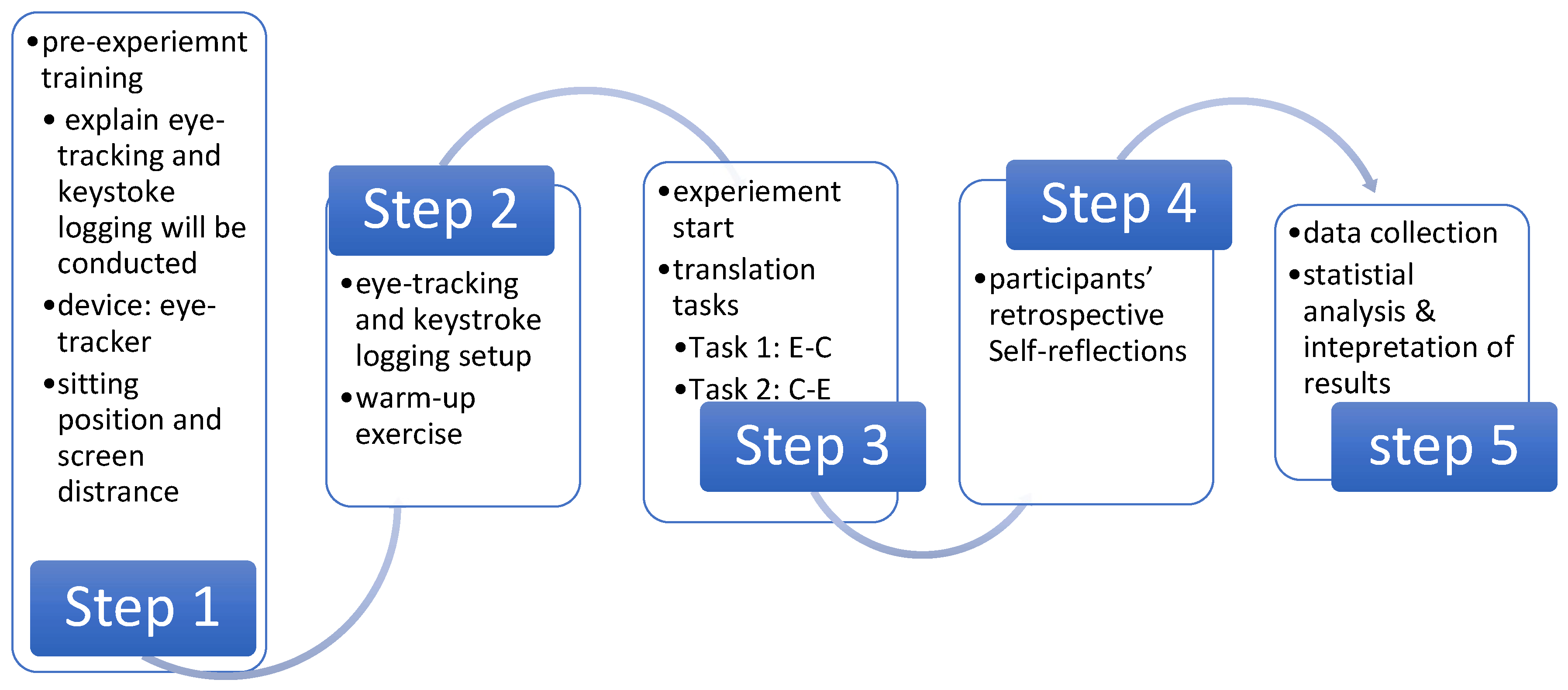
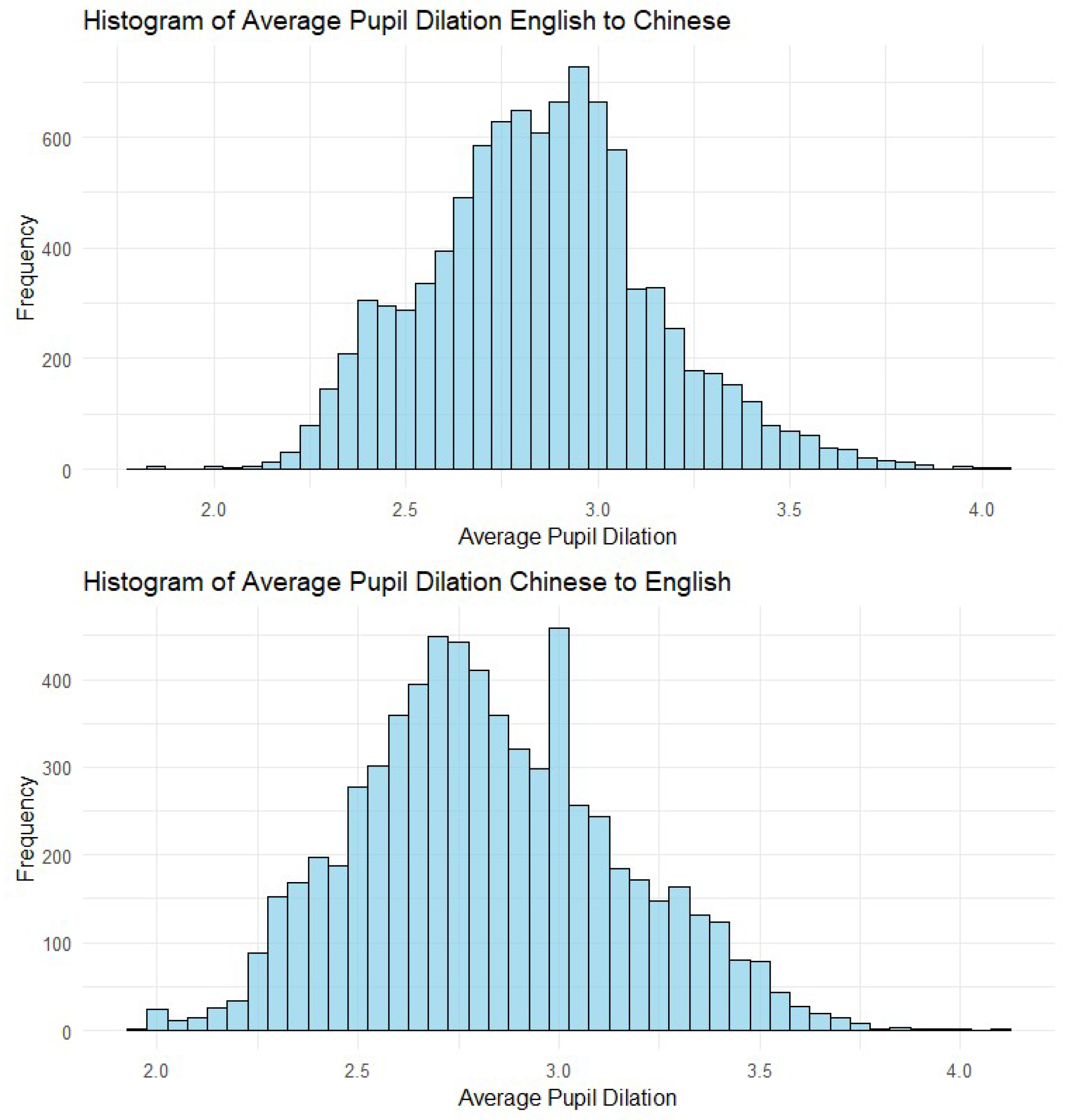



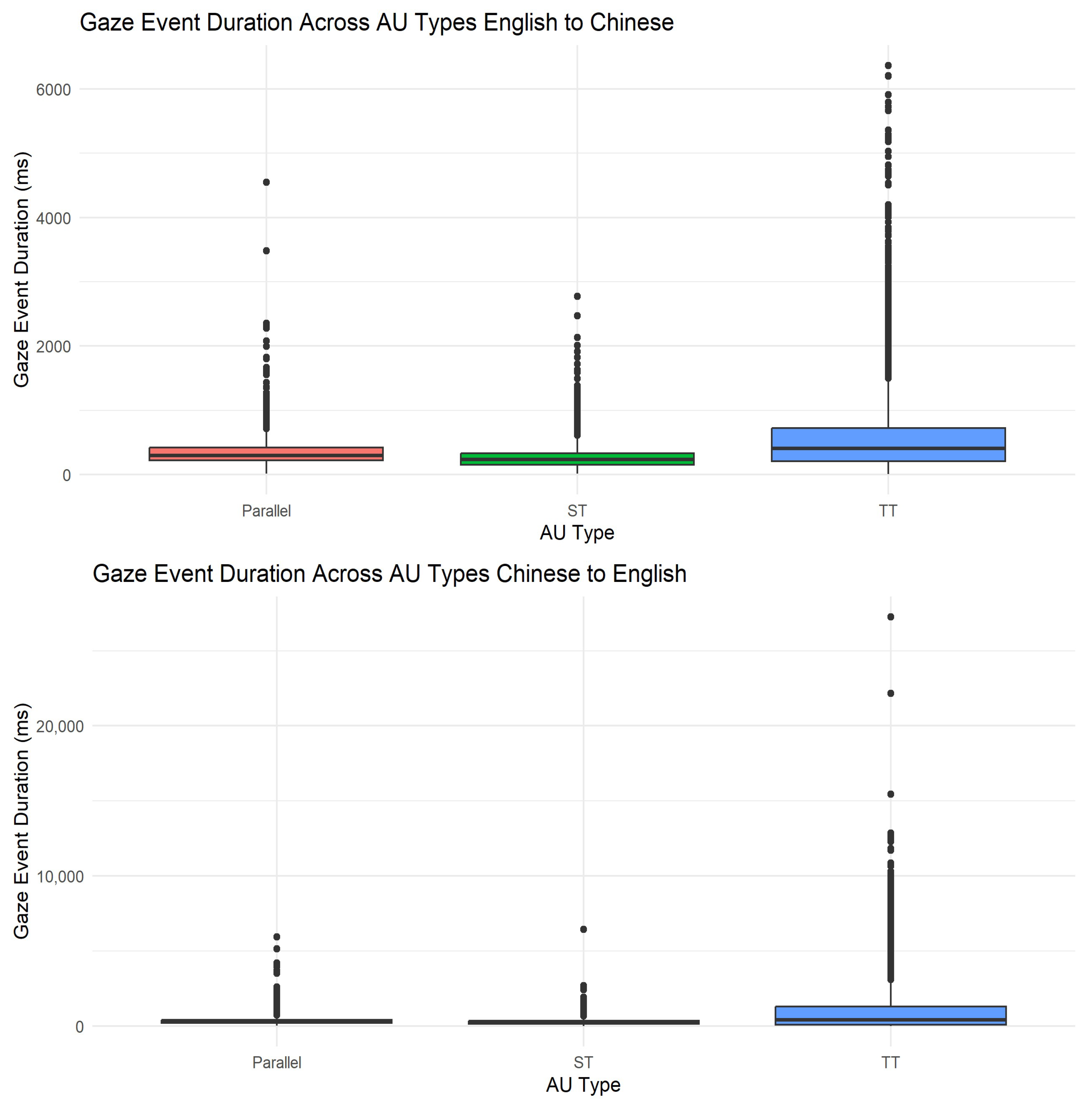
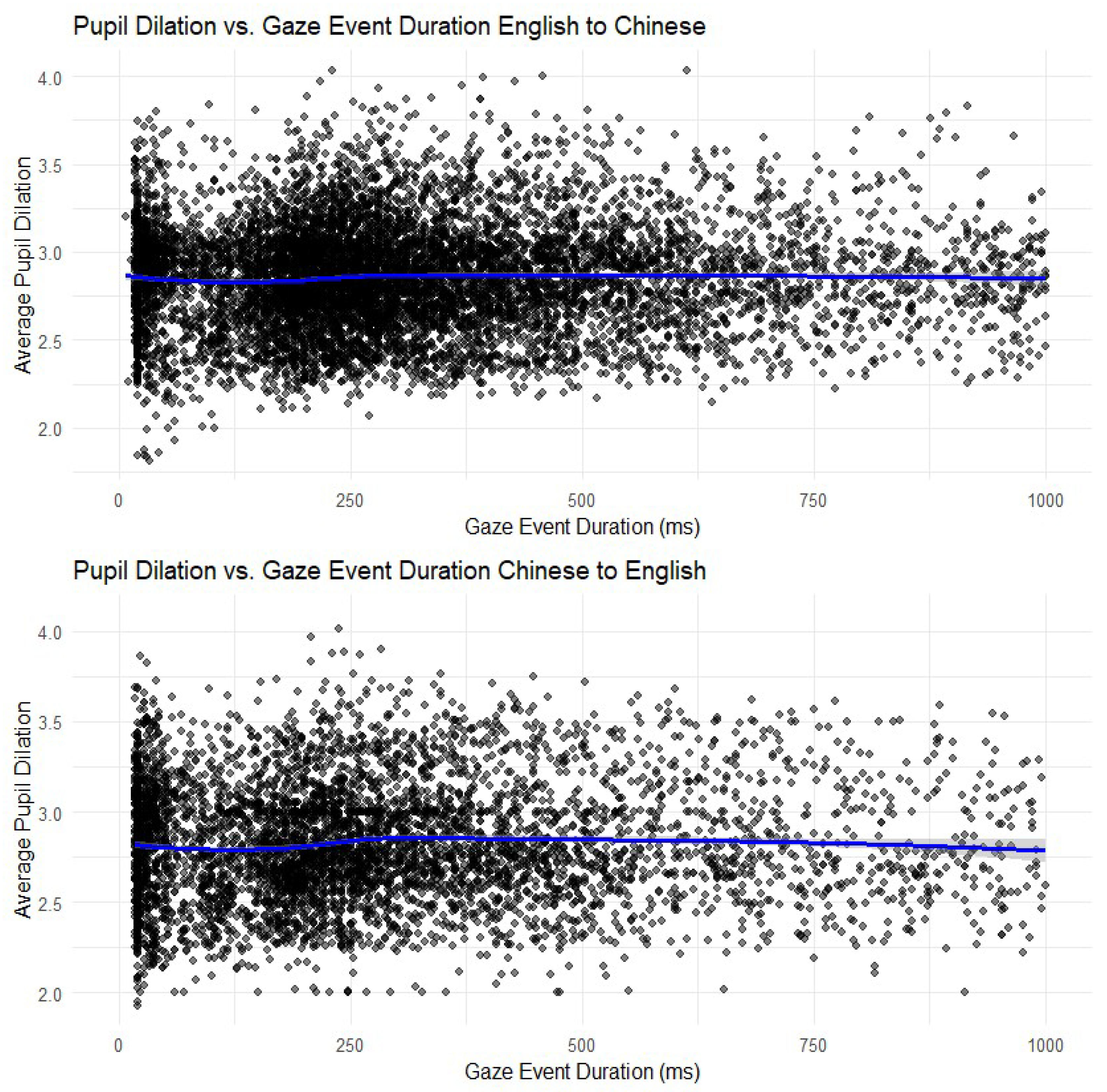
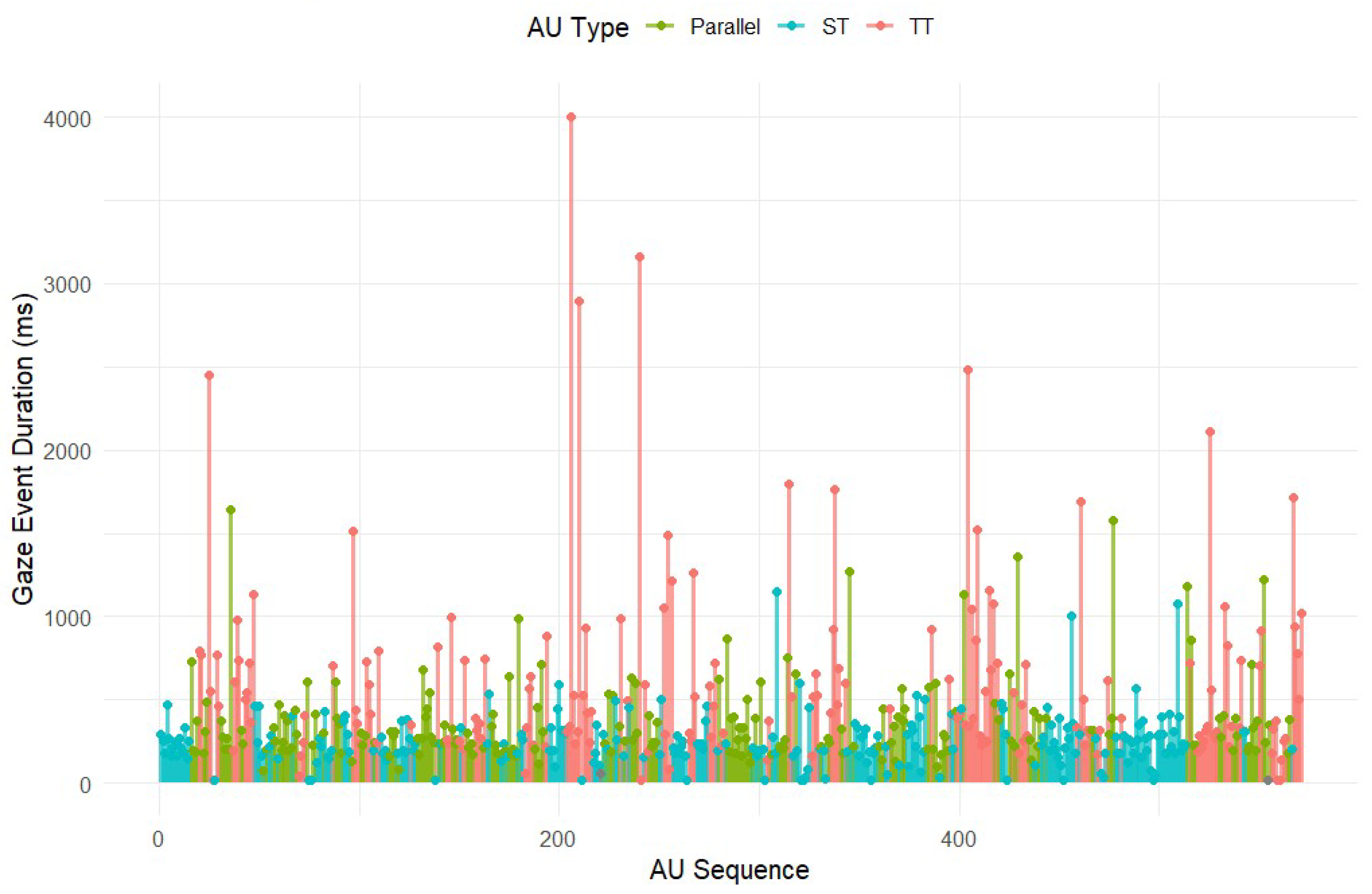
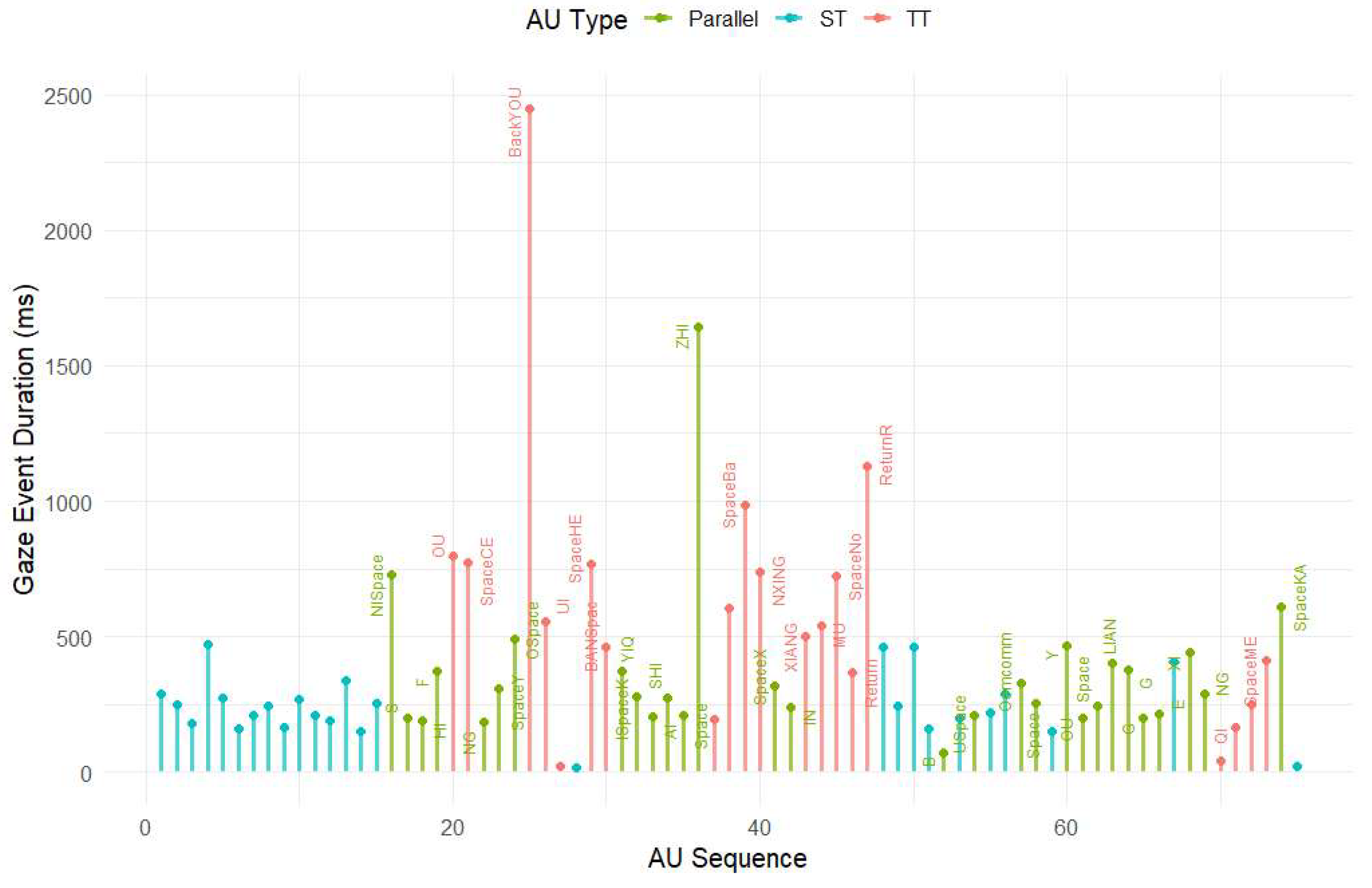
| AUs Classification | Macro AUs | Micro AUs | Details |
|---|---|---|---|
| Group A | ST AU (Source Text Attention Unit) | ST Gaze | Corresponds to ST comprehension; includes eye gaze on ST and typing without gaze. |
| Group B | TT AU (Target Text Attention Unit) | Gaze Off + Typing No Gaze + Typing TT Gaze + Typing TT Gaze | Corresponds to TT production; includes gaze on TT and typing activity. |
| Group C | Parallel AU | ST Gaze + Typing | Reflects simultaneous ST and TT processing. |
| Group D | No data | Gaze Off | Inactive moments, pauses, or unclassified activities. |
| Variable | Description | Comment | Categories |
|---|---|---|---|
| FixationIndex | Unique ID for fixation | [1:936] | - |
| Participant | Unique ID for participant | Factor with 18 levels | P01, P02, P03, P04, P05, P08, P09, P10, P11, P12, P13, P14, P16, P17, P18, P19, P20, P22 |
| AU_type | The task which is currently being performed | Factor with 3 levels | 1: parallel, 2: source text (ST), 3: target text (TT) |
| FixationPointY (MCSpx) | Point on the screen of gaze along the y-axis | [0:900] | - |
| GazeEventDuration | The amount of time spent gazing at a single point, recorded in (ms) | [0:9500] | - |
| KeyDefinition | The label generated by the eye tracking software | This takes the form of a string | - |
| FixationPointX (MCSpx) | Point on the screen of gaze along the x-axis | [0:1400] | - |
| PupilLeft | The dilation of the left eye pupil | Continuous | - |
| PupilRight | The dilation of the right eye pupil | Continuous | - |
| AVGpupildillation | The average pupil dilation of both pupils | Continuous | - |
| English-to-Chinese (E-C) Translation Direction | ||||||
|---|---|---|---|---|---|---|
| Variable | Min | 1st Qu. | Median | Mean | 3rd Qu. | Max |
| PupilLeft | 1.690 | 2.658 | 2.885 | 2.853 | 3.012 | 3.912 |
| PupilRight | 1.466 | 2.645 | 2.811 | 2.852 | 3.043 | 4.197 |
| AVGpupildillation | 1.812 | 2.655 | 2.853 | 2.853 | 3.029 | 4.033 |
| Chinese to English (C-E) Translation Direction | ||||||
| Variable | Min | 1st Qu. | Median | Mean | 3rd Qu. | Max |
| PupilLeft | 1.800 | 2.606 | 2.827 | 2.817 | 3.004 | 4.000 |
| PupilRight | 1.899 | 2.594 | 2.773 | 2.838 | 3.072 | 4.184 |
| AVGpupildillation | 1.927 | 2.602 | 2.799 | 2.828 | 3.032 | 4.090 |
| Predictor | Estimate | p-Value | Interpretation |
|---|---|---|---|
| Intercept | 3.138 | <0.001 *** | Baseline pupil dilation (parallel processing, reference participant). |
| AU_typeST | −0.0356 | <0.001 *** | ST processing significantly reduces pupil dilation compared to parallel processing. |
| AU_typeTT | −0.0140 | 0.033 * | TT processing slightly reduces pupil dilation relative to parallel processing. |
| GazeEventDuration | −0.000028 | 0.026 * | Longer gaze durations are associated with a small but significant decrease in pupil dilation. |
| AU_typeST:GazeEventDuration | −0.000018 | 0.265 | Not significant: gaze duration does not significantly alter pupil dilation in ST processing. |
| AU_typeTT:GazeEventDuration | 0.000039 | 0.0026 ** | Significant: longer gaze durations increase pupil dilation in TT processing. |
| Predictor | Estimate | p-Value | Interpretation |
|---|---|---|---|
| Intercept | 3.092 | <0.001 *** | Baseline pupil dilation (parallel processing, reference participant). |
| AU_typeST | −0.0077 | <0.285 *** | Not significant: ST processing does not significantly differ from parallel processing. |
| AU_typeTT | −0.0475 | <0.001 *** | TT processing significantly reduces pupil dilation compared to parallel processing. |
| GazeEventDuration | 0.0000076 | <0.001 *** | Longer gaze durations are significantly associated with increased pupil dilation. |
| Allocation of Cognitive Resources to ST and TT | Allocation of Cognitive Resources to ST and TT | ||||||
|---|---|---|---|---|---|---|---|
| S1–3 | S4–6 | S7–9 | S1–3 | S4–6 | S7–9 | ||
| P01 | 60/40 | 50/50 | 50/50 | P12 | 60/40 | 70/30 | 80/20 |
| P02 | 40/60 | 40/60 | 40/60 | P13 | 60/40 | 60/40 | 65/35 |
| P03 | 50/50 | 60/40 | 60/40 | P14 | 50/50 | 60/40 | 60/40 |
| P04 | 50/50 | 50/50 | 30/70 | P15 | 50/50 | 50/50 | 50/50 |
| P05 | 30/70 | 40/60 | 50/50 | P16 | 50/50 | 50/50 | 50/50 |
| P06 | 60/40 | 60/40 | 60/40 | P17 | 70/30 | 70/30 | 70/30 |
| P07 | 50/50 | 60/40 | 60/40 | P18 | 40/60 | 40/60 | 50/50 |
| P08 | 50/50 | 60/40 | 60/40 | P19 | 70/30 | 70/30 | 80/20 |
| P09 | 50/50 | 60/40 | 60/40 | P20 | 50/50 | 40/60 | 50/50 |
| P10 | 60/40 | 70/30 | 70/30 | P21 | 60/40 | 70/30 | 80/20 |
| P11 | 50/50 | 50/50 | 50/50 | P22 | 50/50 | 50/50 | 50/50 |
| Allocation of Cognitive Resources to ST and TT | Allocation of Cognitive Resources to ST and TT | ||||||
|---|---|---|---|---|---|---|---|
| S1–3 | S4–6 | S7–9 | S1–3 | S4–6 | S7–9 | ||
| P01 | 40/60 | 30/70 | 30/70 | P12 | 30/70 | 30/70 | 30/70 |
| P02 | 40/60 | 40/60 | 40/60 | P13 | 50/50 | 40/60 | 40/60 |
| P03 | 40/60 | 30/70 | 30/70 | P14 | 30/70 | 30/70 | 30/70 |
| P04 | 20/80 | 30/70 | 50/50 | P15 | 30/70 | 20/80 | 20/80 |
| P05 | 20/80 | S | S | P16 | 40/60 | 40/60 | 35/65 |
| P06 | 40/60 | 50/50 | 50/50 | P17 | 50/50 | 40/60 | 40/60 |
| P07 | 40/60 | 50/50 | 50/50 | P18 | 30/70 | 30/70 | 20/80 |
| P08 | 20/80 | 20/80 | 10/90 | P19 | 50/50 | 45/55 | 40/60 |
| P09 | 40/60 | 30/70 | 20/80 | P20 | 50/50 | 50/50 | 40/60 |
| P10 | 40/60 | 30/70 | 30/70 | P21 | 50/50 | 40/60 | 30/70 |
| P11 | 20/80 | 20/80 | 20/80 | P22 | 50/50 | 45/55 | 30/70 |
Disclaimer/Publisher’s Note: The statements, opinions and data contained in all publications are solely those of the individual author(s) and contributor(s) and not of MDPI and/or the editor(s). MDPI and/or the editor(s) disclaim responsibility for any injury to people or property resulting from any ideas, methods, instructions or products referred to in the content. |
© 2025 by the authors. Licensee MDPI, Basel, Switzerland. This article is an open access article distributed under the terms and conditions of the Creative Commons Attribution (CC BY) license (https://creativecommons.org/licenses/by/4.0/).
Share and Cite
Wang, Y.; Li, S.; Rasmussen, Y.Z. Translators’ Allocation of Cognitive Resources in Two Translation Directions: A Study Using Eye-Tracking and Keystroke Logging. Appl. Sci. 2025, 15, 4401. https://doi.org/10.3390/app15084401
Wang Y, Li S, Rasmussen YZ. Translators’ Allocation of Cognitive Resources in Two Translation Directions: A Study Using Eye-Tracking and Keystroke Logging. Applied Sciences. 2025; 15(8):4401. https://doi.org/10.3390/app15084401
Chicago/Turabian StyleWang, Yifang, Saihong Li, and Yubo Zhou Rasmussen. 2025. "Translators’ Allocation of Cognitive Resources in Two Translation Directions: A Study Using Eye-Tracking and Keystroke Logging" Applied Sciences 15, no. 8: 4401. https://doi.org/10.3390/app15084401
APA StyleWang, Y., Li, S., & Rasmussen, Y. Z. (2025). Translators’ Allocation of Cognitive Resources in Two Translation Directions: A Study Using Eye-Tracking and Keystroke Logging. Applied Sciences, 15(8), 4401. https://doi.org/10.3390/app15084401








